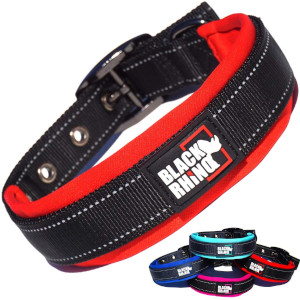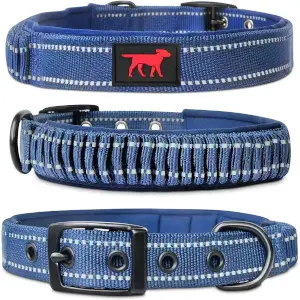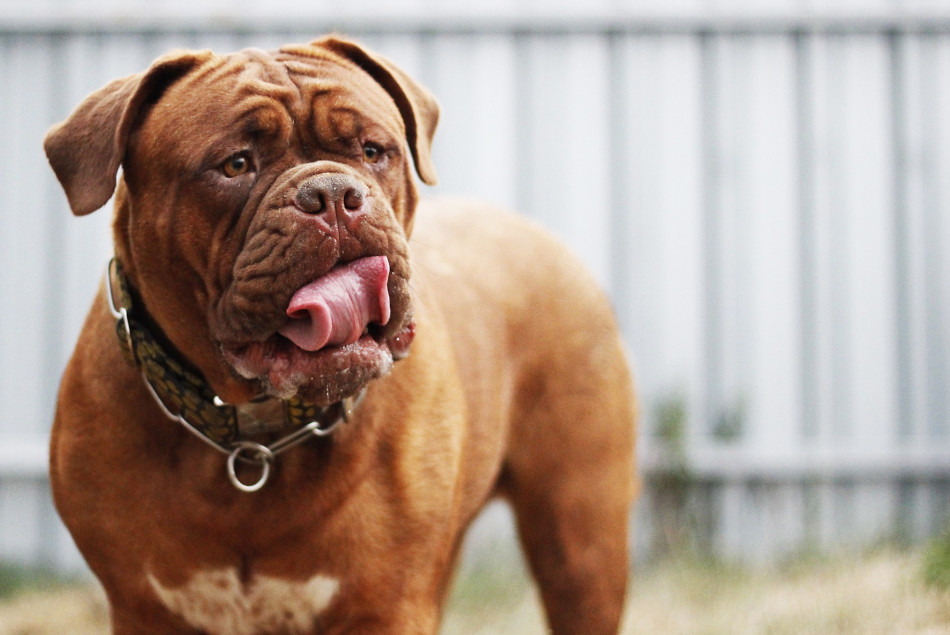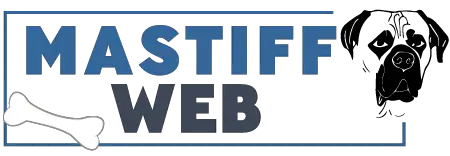What makes one dog collar better than the other? There is more to the decision than you might have thought. To facilitate your purchase, I have distilled all the information you require to make the best choice for your dog.
Table of Contents
Best Heavy-Duty Collars for Mastiffs
Walking into an aisle of dog collars or browsing a selection online can leave you confused and overwhelmed with so much to choose from. Skip the search because I have done the work for you.
Black Rhino
Trust that I have my reasons for calling this my most favorite heavy-duty collar of all time.
After my Mastiff broke three collars in a month, out of sheer desperation, I ordered a random few of the most-reviewed dog collars and prayed for better luck. And man, did I get lucky.
We have been using the Black Rhino neoprene collar for three months now and couldn’t be happier. So far, it has withstood at least a dozen instances of a 200-pound dog bolting at full speed, and the collar and buckle are still going as strong as ever. Need I say more of the durability?
When it comes to big dogs, the strength of the collar is absolutely critical; these dogs are strong, and their collars need to be stronger if you are to avoid the countless loose-dog hazards. Black Rhino has guaranteed that with its impeccable construction (which, I admit, I have closely observed under a lamp) and use of top-quality material.
My dog and I also love the buckle on this collar. I actively avoid metal buckles because they retain heat and make my dog uncomfortable during training on sunny days. However, most of the alternatives to metal that I bought broke down in just a matter of hours – or at best, a few days. This one is an exception that offered both comfort and strength.
I did observe that the collar runs a little small, so play safe and order one size up. Adjusting a bigger size to the dog’s neck is far more comfortable compared to being on the last grommet on a smaller size, anyway.

Yunlep Adjustable Tactical Dog Collar
One of my dogs has been wearing this gorgeous collar for two years now, and she still doesn’t fail to get compliments for it. The hardware and customizable name patch is just one part of it, though. Yunlep really outdid themselves with this product which both works and looks great.
Even after two years of extensive use, the material has not frayed, and the buckle remains secure. I particularly love how there is no fading or tarnishing even after all the swimming this collar has been through. The collar does not chafe at all, and the handle attached also offers added control during hikes and walks. I would go as far as saying that this is as good as a harness when it comes to control. I wanted to buy this collar for other dogs as well, but it only fit the big ones. And that is the only wish this collar left unfulfilled for me.

Tuff Pupper
I got the red variant of this, and let me just say; it made my 5-year-old Bullmastiff look oh-so-handsome. It isn’t all about the looks, though.
My dog did not get bothered by it at all, thanks to the soft material and inner padding. The nylon-neoprene collar is extremely comfortable and not just for the dog. It often rains where we live, and my dogs like to play outside. That means hours of scrubbing out stubborn stains on nylon collars, or even worse, worrying about our expensive leather collars getting wet and dirty. No more!
This Tuff Pupper collar dries up so quickly, and I have still not noticed any dampness or odor in my few months of use. It’s also machine-washable, but because of the metal buckle on it, I opted for handwashing. So, if your dog also gets too dirty too often, go for this collar because it’s that easy to keep clean!
It’s an exceptionally well-built product, but the handle could have been a little less elastic to offer more control. However, since I don’t need that kind of control with my dog, this works just fine for me.

Types of Dog Collars
Everyday Dog Collars
This is the standard dog collar that is worn around the house or on casual walks. Everyday collars are typically manufactured out of nylon, neoprene, or leather and have plastic or metal buckles as fastenings. These collars are designed for dogs that can be kept off leash.
Everyday collars are primarily used to carry dog IDs and for ‘fashion’ purposes. Therefore, the security of the buckle and the design of the collar are often important variables.
Another feature I find extremely valuable in everyday collars is moisture-wicking. These collars, made out of neoprene, are waterproof and quick-drying, which makes them great for dogs living in wet climates or spending a lot of time in the water because the collar will remain dry, odorless, and bacteria-free. Since they are to be worn for long periods of time, everyday collars should also be easy to clean, comfortable to wear, and durable.
Training Dog Collars
Traditional training collars employed inhumane methods of training a dog into obedience and ended up traumatizing the animal. These include shock collars and choke chains, which are now banned across many countries and strongly criticized.
To rectify the situation, modern training collars have been developed to train your dog, but not at the expense of its comfort and safety. These training collars are remote-controlled and send out ‘vibrations’ as a form of discipline.
Sadly enough, even today, some of these training collars come with metal prongs on the inside to prevent the dog from pulling on the collar. This is why critics continue to oppose the use of training collars in any way, and safer alternatives like the Martingale collar have been introduced.
Martingale Dog Collars
Martingale collars are a form of training collars similar to choke chains but more comfortable and relatively safer. The ethicality of these is sometimes debated, but the general opinion is that these are okay to use if used under strict supervision and that too, sparingly.
These collars are half nylon and half chain. The nylon helps protect the dog’s trachea and esophagus in case the dog pulls by cinching up to an extent. Alternatively, to prevent fur from falling out in long-haired dogs, all-fabric Martingales are also available. These don’t have a chain section and are therefore softer.

Alternatives
Harness
Dog harnesses go around the dog’s body instead of the neck, therefore taking the pressure off the neck in case of pulling. They also allow greater control than collars in many cases.
While both harnesses and collars are great tools for walking or managing your dog, they are not exactly ‘perfect alternatives.’ Collars are important for all dogs to be wearing with their IDs at all times and are also inarguably more comfortable than harnesses for that kind of 24/7 wear. On the other hand, harnesses are the better choice for training and controlled walks.
Headcollars
Headcollars control the dog’s head by limiting its range of motion. If the dog cannot move its head too much, it cannot pull on its leash as well. That might sound like good training, but it’s, in fact, the opposite: your dog may never learn to walk on a leash by itself if always kept in a head collar. Moreover, head collars are fairly uncomfortable for the animal.
Over my years of experience with dogs, I have come to learn that head collars are just unnecessary. What looks like a benefit (decreased risk of pulling) is actually poor training. If you really are to use one, try phasing it out sooner than later.
Materials
Nylon Dog Collars
Nylon collars are the most common type of dog collars. Available in a myriad of designs, colors, widths, and price points, nylon collars are typically everyday-use collars.
These are inexpensive, easily available, and widely customizable. With newer materials like neoprene on the block, nylon has become an even more popular material for a dog collar. Nylon and neoprene combine to make some of the best dog collars, which are quick-drying, easy to clean, comfortable to wear, low-maintenance, long-lasting, and great-looking!
Leather (PU Leather)
Leather collars don’t only look great but are also sturdier compared to other materials. Naturally, they are also much pricier.
Some dog owners choose leather collars solely for their visual appeal. While this aesthetic superiority is a perfectly legitimate motive, another reason often pushing us dog owners in the direction of leather collars is a nylon allergy. Albeit uncommon, an allergic reaction to nylon collars is occasionally observed in dogs. Leather collars are your safest, smartest bet in such a scenario.
Do consider that good-quality leather leashes usually come with a heavy price tag. Definitely go for it if you can afford to, but if the price is making you choose between quality or appearance, I strongly advise prioritizing durability over looks.
Neoprene
A soft yet strong rubber material, neoprene is a relatively new medium for dog collars.
Its key selling point is that it is waterproof. This makes it a great choice for dogs that spend time in water; its moisture-wicking feature will keep the collar odor-free and bacteria-free and also keep your dog comfortable. Collars made out of neoprene are soft and limit chafing complaints to a minimum. Neoprene is also good for dogs with skin allergies; however, in case your dog is allergic to nylon, be mindful that neoprene collars are also often reinforced with nylon mesh.
Neoprene collars are priced slightly above regular nylon collars, but with their durability, design, and comfort, they are well worth the premium.
Chains
Some dog owners use chains as leashes, and that is unfortunate, to say the least. People typically resort to the use of chains when the dog develops a pattern of pulling on and breaking off its collar.
However, the solution to that is never a chain: if pulled against enough, the chain can cause irreversible physical damage to the dog, sometimes even causing their eyes to bulge. Common injuries include tracheal damage, cervical damage, muscle injuries, and chafing. This makes chains dangerous, cruel, unethical, and simply a total no-go as a walking or everyday collar. Perhaps the only justifiable use of chains is during supervised training.
Buckles
Dog collars come fitted with either clips or buckles as closure. Buckles are the clear choice for big dogs because they are more secure and hard-wearing. Buckles also permit you to attach your dog’s ID and leash to the collar and will keep them in place. However, keep in mind that in case of an emergency, buckle collars are not quick-release.
FAQ
Is a Wide Collar Better?
Wide collars are ideal for everyday use, walking, and training. They offer better control, are more secure, and also prevent your dog from injuries. This is especially true for big dogs with large necks.
Firstly, if a dog has a neck wider than its head, it can conveniently slip out of a regular width collar. If the collar is instead wide, the dog will not be able to easily push it over its head. This will keep your dog’s ID and collar safely in place and also help the dog feel more secure.
Similarly, if a dog with a large neck pulls on its regular width collar, all the force applied will be centralized into a thin strip and can even start cutting into the animal’s neck. However, if the collar is wide, the tension will be spread out over a wider area and therefore keep excess pressure off the dog’s neck. This can help safeguard against potential injuries.
Conclusion
There are many good dog collar options available, depending on the needs of your dog. However, a rule of thumb to follow is, get a wide collar with a secure buckle fastening and make sure it is easy to clean and maintain. Happy shopping!
